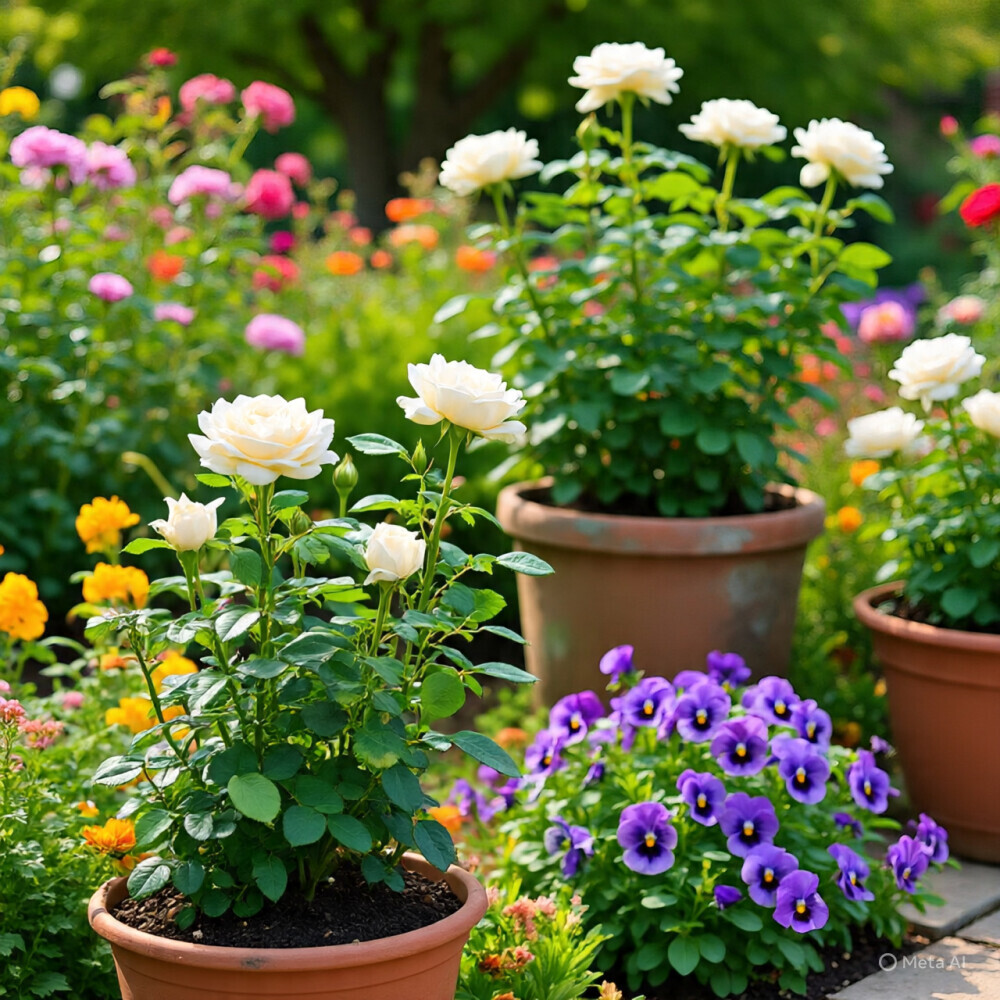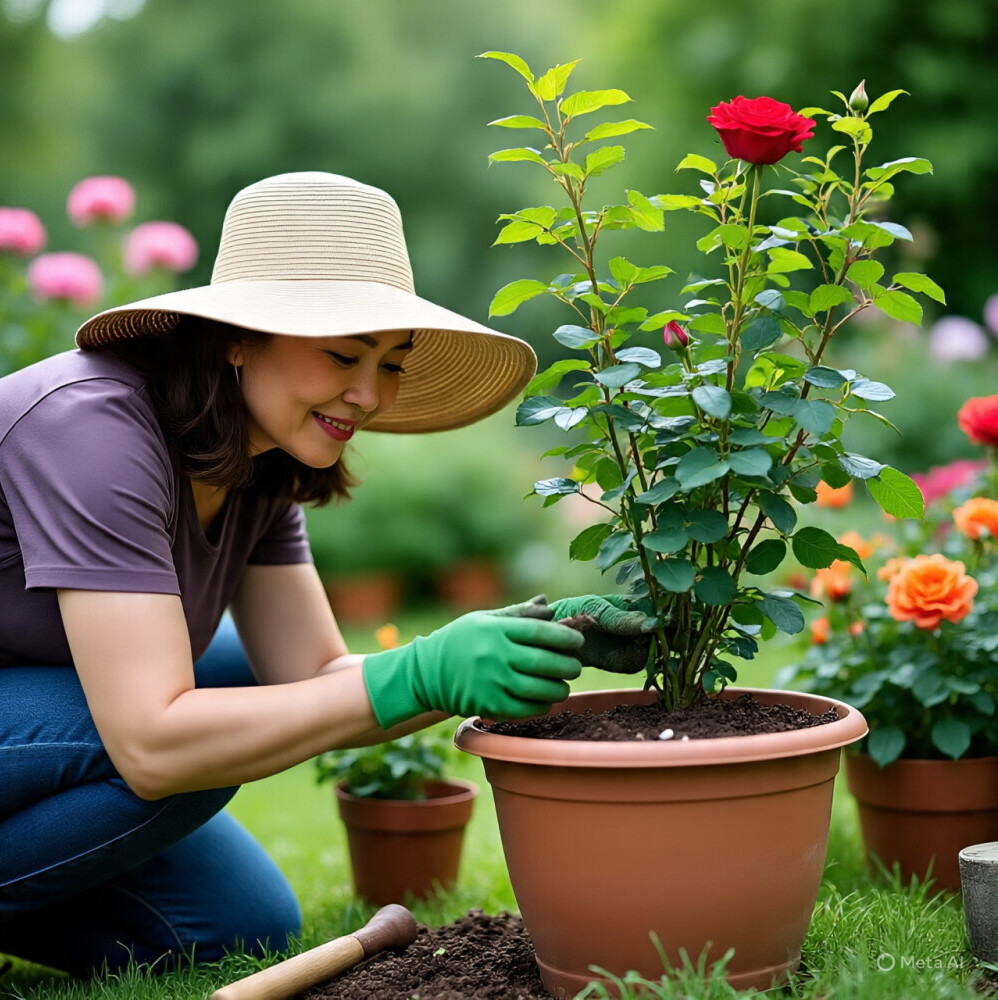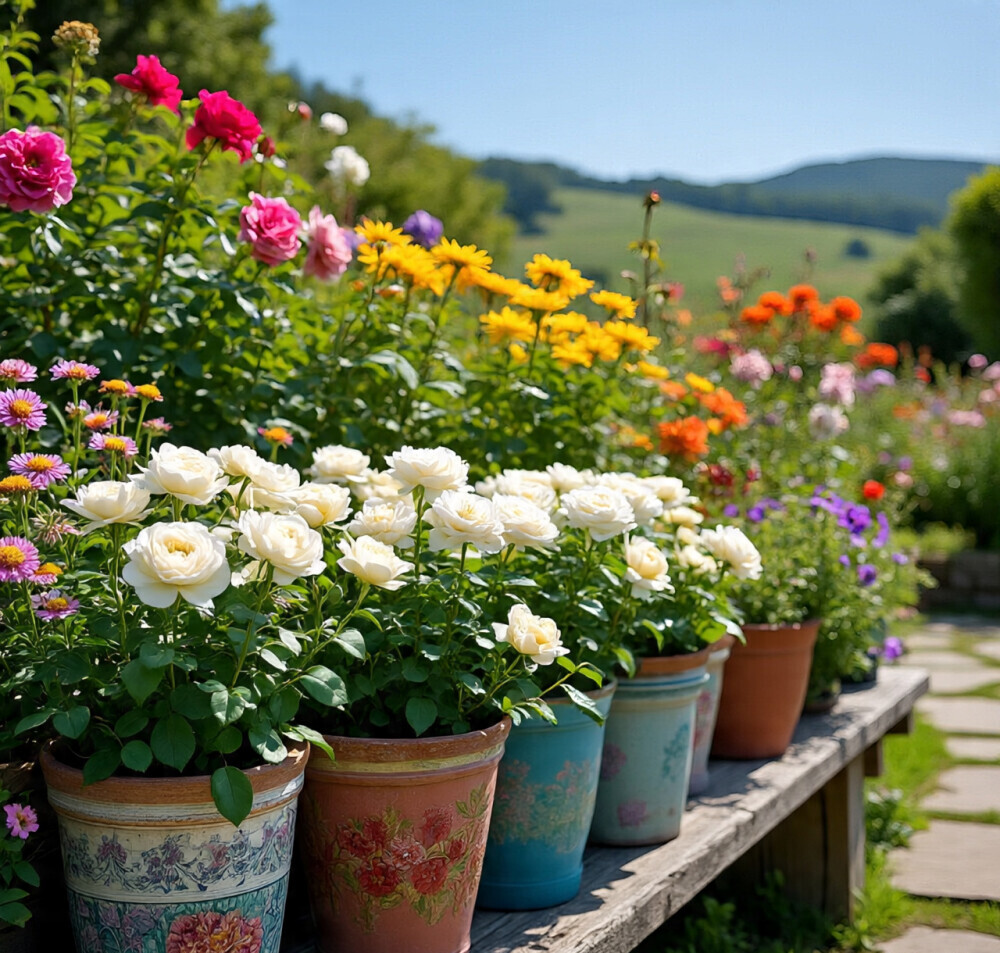Iceberg roses, celebrated for their prolific blooms, disease resistance, and elegant charm, can thrive beautifully in containers.
Whether you have a small patio, balcony, or deck, growing Iceberg roses in containers allows you to enjoy their beauty and fragrance in a versatile way.
With proper planning and care, your container-grown roses can be a stunning focal point in your outdoor space.
This guide will walk you through everything you need to know to grow Iceberg roses successfully in containers.
Benefits of Growing Iceberg Roses in Containers
Growing Iceberg roses in containers offers unique advantages:
- Flexibility: You can move the containers to optimize sunlight or protect them from harsh weather conditions.
- Space-Saving: Perfect for small spaces like patios, balconies, or urban gardens.
- Control: Containers allow better control over soil conditions, watering, and fertilization.
- Aesthetic Appeal: A well-chosen container enhances the visual impact of your Iceberg roses, creating a beautiful garden feature.
Choosing the Right Container
Selecting the proper container is crucial for the health and growth of your Iceberg roses.
- Size Matters:
-
- The container should be large enough to accommodate the mature size of the rose bush. A minimum diameter of 12-15 inches and a depth of at least 18 inches is recommended to allow room for root growth.
- Larger containers help retain moisture and reduce the frequency of watering.
- Drainage:
-
- Ensure the container has adequate drainage holes to prevent waterlogging, which can lead to root rot.
- If the container lacks drainage holes, drill some before planting.
- Material:
-
- Choose durable materials like terracotta, ceramic, or plastic.
- Terracotta is breathable but may dry out faster, whereas plastic retains moisture longer and is lighter for easy movement.
- Aesthetic Considerations:
-
- Select a container that complements your garden design. Decorative containers can enhance the overall appeal of your Iceberg rose display.
- Recommended: The Lechuza Self-Watering Planter is an excellent option because it keeps soil moisture balanced with minimal effort.
Preparing the Container and Soil
Proper preparation sets the foundation for a thriving Iceberg rose.
- Clean the Container:
-
- Wash the container thoroughly with soap and water to remove any debris or pathogens.
- Add Drainage Material:
-
- Place a layer of gravel, broken pottery, or small stones at the bottom to improve drainage. This prevents water from pooling around the roots.
- Choose the Right Soil:
-
- Use a well-draining potting mix specifically formulated for roses.
- Enrich the soil with organic matter like compost or well-rotted manure to provide essential nutrients.
- Avoid garden soil, as it can become compacted in containers, restricting root growth.
- Recommended: Try Rose and Flower Mix for excellent drainage and nutrient support.
Planting the Iceberg Rose
Planting Iceberg roses in containers requires a careful approach to ensure healthy root establishment.
- Prepare the Roots:
-
- Gently loosen the roots of the rose bush before planting to encourage outward growth. Soak the roots in water for 30 minutes to an hour if they appear dry.
- Position the Rose:
-
- Place the rose in the center of the container, ensuring the graft union (the point where the scion and rootstock meet) is 2-3 inches below the soil surface.
- Backfill with Soil:
-
- Fill the container with potting mix, gently firming the soil around the roots to eliminate air pockets. Avoid compacting the soil too tightly.
- Water Thoroughly:
-
- Water the newly planted rose thoroughly to settle the soil and hydrate the roots. Ensure excess water drains out.
Post-Planting Care
Consistent care is essential for the health and beauty of your container-grown Iceberg roses.
- Watering:
-
- Water regularly, especially during dry periods. Allow the top inch of soil to dry slightly between waterings.
- In hot weather, you may need to water daily to keep the soil consistently moist.
- Fertilizing:
-
- Use a balanced rose fertilizer every 4-6 weeks during the growing season to promote healthy growth and abundant blooms.
- Consider slow-release fertilizers for consistent nutrient supply.
- Recommended: Use Osmocote Smart-Release Plant Food for steady, season-long nutrition.
- Pruning:
-
- Lightly prune after the first flush of blooms to encourage repeat flowering. Remove dead, damaged, or crossing branches to maintain a healthy shape.
- Pest and Disease Monitoring:
-
- Regularly inspect your roses for signs of pests like aphids, spider mites, or thrips. Treat infestations promptly with insecticidal soap or neem oil.
- Watch for fungal diseases such as black spot or powdery mildew, especially in humid conditions. Remove affected leaves and apply fungicides if necessary.
- Recommended: Protect your roses naturally with Neem Oil Spray, which controls pests and diseases organically.
- Winter Protection:
-
- In colder climates, move the container to a sheltered location or indoors during winter.
- Wrap the container in insulating material like burlap or bubble wrap to protect the roots from freezing temperatures.
Tips for Success
- Sunlight: Ensure your Iceberg rose receives at least 6-8 hours of direct sunlight daily. Insufficient light can result in fewer blooms and weaker growth.
- Support: For taller or bushier growth, provide support with stakes or trellises to prevent the plant from becoming top-heavy.
- Rotation: Rotate the container every few weeks to ensure even sunlight exposure and balanced growth.
- Re-potting: Re-pot the rose every 2-3 years to refresh the soil and accommodate root growth.
Common Challenges and Solutions
- Wilting or Drooping Leaves:
-
- Cause: Overwatering or underwatering.
- Solution: Check soil moisture and adjust your watering schedule accordingly.
- Yellowing Leaves:
-
- Cause: Nutrient deficiency or water stress.
- Solution: Apply a balanced fertilizer and ensure consistent watering.
- Poor Bloom Production:
-
- Cause: Insufficient sunlight or over-fertilization.
- Solution: Move the container to a sunnier location and avoid excessive fertilization.
- Pests and Diseases:
-
- Cause: Humid conditions or lack of monitoring.
- Solution: Maintain good air circulation, inspect plants regularly, and treat problems early.
FAQs About Growing Iceberg Roses in Containers
i. Can Iceberg roses thrive in containers?
Yes, Iceberg roses can thrive in containers with the right care. Containers offer flexibility, space efficiency, and the ability to move your plants as needed for optimal sunlight or to protect them from extreme weather. With proper soil, drainage, and regular care, Iceberg roses can be a stunning feature in your container garden.
ii. What size container is best for Iceberg roses?
For Iceberg roses, a container with a minimum diameter of 12-15 inches and a depth of at least 18 inches is ideal. A larger container provides ample room for root growth, helps retain moisture, and reduces the frequency of watering. Ensure the container is large enough to accommodate the mature size of the plant.
iii. What type of soil should I use for Iceberg roses in containers?
Use a well-draining potting mix specifically designed for roses. This soil should be light, rich in organic matter, and should drain easily to prevent waterlogging. Avoid using regular garden soil as it can become compacted in containers, restricting root growth.
iv. How often should I water Iceberg roses in containers?
Water regularly, especially during hot weather or dry periods. The top inch of soil should dry out slightly before watering again. In hot weather, you may need to water daily to ensure the soil remains consistently moist. Ensure the container has drainage holes to avoid waterlogging, which can harm the plant.
v. Do I need to fertilize Iceberg roses in containers?
Yes, Iceberg roses in containers require regular fertilization. Use a balanced rose fertilizer every 4-6 weeks during the growing season to encourage healthy growth and abundant blooms. Consider using slow-release fertilizers for consistent nutrient supply throughout the season.
vi. How do I prune Iceberg roses in containers?
Prune Iceberg roses after their first flush of blooms to encourage repeat flowering. Remove dead, damaged, or crossing branches to maintain a healthy shape. Light pruning helps keep the plant manageable and promotes air circulation, reducing the risk of disease.
vii. What kind of sunlight do Iceberg roses need in containers?
Iceberg roses need at least 6-8 hours of direct sunlight per day for optimal growth and blooming. If your container is placed in a location with insufficient sunlight, the plant may produce fewer blooms and exhibit weaker growth. Ensure the container is in a sunny spot or rotate it to ensure even exposure.
viii. Can Iceberg roses in containers survive winter?
In colder climates, Iceberg roses may require winter protection. You can move the container to a sheltered location, like a garage or indoors, to protect the roots from freezing. Additionally, wrapping the container in insulating materials like burlap or bubble wrap will help keep the roots warm during the winter months.
ix. How can I prevent pests and diseases on my container-grown Iceberg roses?
Regularly inspect your Iceberg roses for pests such as aphids, spider mites, and thrips. Use insecticidal soap or neem oil to treat infestations. Also, monitor for fungal diseases like black spot or powdery mildew, which can be exacerbated by humidity. Ensure good air circulation around the plant to reduce the risk of disease.
x. What should I do if my Iceberg roses are not blooming?
If your Iceberg roses are not blooming, it could be due to insufficient sunlight, over-fertilization, or water stress. Ensure your roses receive at least 6-8 hours of direct sunlight per day. Avoid excessive fertilization, as this can lead to lush foliage at the expense of blooms. Check your watering schedule and ensure the soil is consistently moist but not waterlogged.
xi. How do I support Iceberg roses in containers if they become top-heavy?
If your Iceberg roses grow tall or become top-heavy, you can provide support by using stakes, trellises, or tomato cages. This will help keep the plant upright and prevent it from falling over or becoming damaged by wind or heavy rain.
xii. Can I grow Iceberg roses in containers year-round?
Yes, Iceberg roses can be grown in containers year-round if they are protected from harsh weather in colder climates. In warmer climates, they can thrive throughout the year with proper care, including consistent watering, fertilizing, and sunlight.
xiii. How do I re-pot Iceberg roses in containers?
Re-pot your Iceberg roses every 2-3 years to refresh the soil and accommodate their growing roots. When re-potting, choose a slightly larger container, fill it with fresh potting mix, and gently loosen the roots before placing them in the new container. Water thoroughly after re-potting.
Conclusion
Growing Iceberg roses in containers is a rewarding way to enjoy their timeless beauty, even in small spaces.
With the right container, soil, and care, these roses can thrive and bloom profusely, adding a touch of elegance to any patio, balcony, or deck.
By following this comprehensive guide and addressing potential challenges, you can create a stunning container garden that showcases the charm and resilience of Iceberg roses.
Whether you’re an experienced gardener or a beginner, container gardening with Iceberg roses offers endless possibilities to enhance your outdoor space.
Our Top Amazon Picks for Growing Iceberg Roses
To make your container rose gardening easier and more successful, here are our recommended products:
- 🌿 Lechuza Self-Watering Planter – Keeps soil moisture balanced.
- 🌸 Rose and Flower Mix – Perfect soil blend for container roses.
- 💧 Osmocote Smart-Release Plant Food – Ensures healthy growth and repeat blooms.
- 🐞 Neem Oil Spray – Organic pest and disease control.
Happy gardening !!!!!!!!!!!!
Here’s a little transparency: Our website contains Amazon affiliate links. This means if you click and make a purchase, we may receive a small commission. Don’t worry, there’s no extra cost to you. It’s a simple way you can support our mission to bring you quality content.”





Thank you for this detailed and practical guide on growing Iceberg roses in containers. I appreciate how you emphasize the importance of selecting the right container size, ensuring proper drainage, and providing adequate sunlight. Your tips on soil preparation and watering practices are especially helpful for gardeners like me who are new to container rose cultivation. One question I have is: How do you recommend managing the growth of Iceberg roses in containers to prevent them from becoming too leggy or overgrown? Are there specific pruning techniques or maintenance practices that can help maintain their shape and encourage healthy blooming?
Thank you again for sharing your expertise! ~Leahrae
Hi Leahrae,
Thank you so much for your thoughtful comment.
I’m so glad you found the guide helpful, and I’m happy to hear the tips on container size, drainage, soil preparation, and watering were useful for you!
Great question about managing the growth of Iceberg roses in containers. To prevent them from becoming too leggy or overgrown, regular pruning is key. Here are a few tips to help maintain their shape and encourage healthy blooming:
Pruning: Aim to prune your Iceberg roses in early spring, just before new growth begins. Remove any dead or damaged wood first, and then trim back any long, leggy stems to encourage a more compact shape. You can also “deadhead” spent blooms throughout the growing season to promote more flowering.
Cutting Back: If the plant gets too tall or leggy, you can cut it back by about one-third to maintain its shape. This will also encourage strong, healthy growth and more blooms.
Pinching: For a bushier, fuller appearance, pinch back the tips of young stems throughout the growing season. This encourages side shoots to form, creating a denser, more compact plant.
Support: While Iceberg roses are generally strong, adding a small trellis or support can help keep them upright and prevent them from becoming too sprawling.
With these techniques, your Iceberg roses should stay healthy, well-shaped, and continue blooming beautifully throughout the season.
Thanks again for your kind words, and I hope these tips help.
Best regards
Raymond